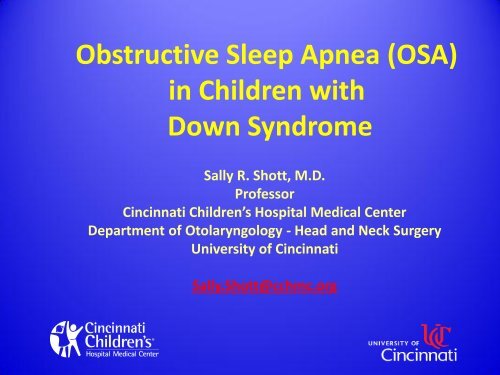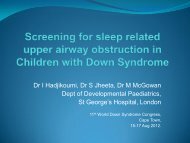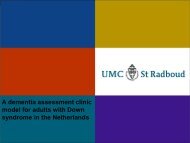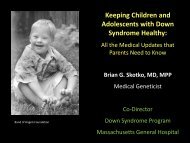Obstructive Sleep Apnea Syndrome in Children
Obstructive Sleep Apnea Syndrome in Children
Obstructive Sleep Apnea Syndrome in Children
Create successful ePaper yourself
Turn your PDF publications into a flip-book with our unique Google optimized e-Paper software.
<strong>Obstructive</strong> <strong>Sleep</strong> <strong>Apnea</strong> (OSA)<br />
<strong>in</strong> <strong>Children</strong> with<br />
Down <strong>Syndrome</strong><br />
Sally R. Shott, M.D.<br />
Professor<br />
C<strong>in</strong>c<strong>in</strong>nati <strong>Children</strong>’s Hospital Medical Center<br />
Department of Otolaryngology - Head and Neck Surgery<br />
University of C<strong>in</strong>c<strong>in</strong>nati<br />
Sally.Shott@cchmc.org
OSA – <strong>Obstructive</strong> <strong>Sleep</strong> <strong>Apnea</strong><br />
• What is it<br />
• What are signs and symptoms<br />
• Why do children/adults with Down syndrome<br />
have OSA<br />
• Why is it important to treat<br />
• Why do we have to get a sleep study
<strong>Obstructive</strong> <strong>Sleep</strong> <strong>Apnea</strong> <strong>Syndrome</strong><br />
(OSAS)<br />
• Episodes of partial or complete airway<br />
obstruction dur<strong>in</strong>g sleep<br />
• Usually associated with:<br />
– Decrease <strong>in</strong> oxygen level - hypoxemia<br />
– and/or hypercarbia (high CO²)
OSAS<br />
• Prevalence: 2% or 500,000 children with<br />
OSAS <strong>in</strong> the USA<br />
• Peak age is 2 to 5 years (developmental peak<br />
of T&A hypertrophy)<br />
• Second peak <strong>in</strong> middle to late adolescence<br />
(more ‘adult’ symptoms)<br />
• <strong>Children</strong> male = female<br />
• Adolescent male > female
OSA<br />
• More difficult to diagnosis <strong>in</strong> children than<br />
adults<br />
• Signs and symptoms may not accurately<br />
reflect severity of disease
OSA – Present<strong>in</strong>g symptoms will<br />
determ<strong>in</strong>e who treats first<br />
• Snor<strong>in</strong>g - seen by ENT<br />
• Failure to thrive - seen by pediatrician<br />
• <strong>Sleep</strong>y children - seen by neurologist<br />
• Behavior problem - seen by psych, treated for ADHD<br />
• Difficulty breath<strong>in</strong>g - seen by pulmonary
• Not diagnostic of OSA<br />
Diagnosis of OSAS<br />
Snor<strong>in</strong>g<br />
• Not always <strong>in</strong>dicative of pathologic breath<strong>in</strong>g<br />
patterns<br />
• <strong>Sleep</strong> architecture can be normal<br />
• Occurs <strong>in</strong> 7 - 10% of children on a regular<br />
basis<br />
• Occurs <strong>in</strong> 20% on an <strong>in</strong>termittent basis
Diagnosis of OSAS<br />
-Increased respiratory effort-<br />
• Correlates with OSA<br />
• Retractions, <strong>in</strong>tercostal, sternal, suprasternal,<br />
supraclavicular, flar<strong>in</strong>g of the nares, use of<br />
accessory muscles, paradoxical <strong>in</strong>ward<br />
motion of the rib cage dur<strong>in</strong>g <strong>in</strong>spiration<br />
• Parents often describe the breath<strong>in</strong>g as<br />
“frighten<strong>in</strong>g”
Diagnosis of OSA<br />
<strong>Sleep</strong> patterns<br />
• Restless sleep or recurrent body<br />
movements, recurrent awaken<strong>in</strong>gs are<br />
seen <strong>in</strong> OSA<br />
<strong>Sleep</strong> Positions<br />
• Bent forward at waist with ch<strong>in</strong> extended<br />
• <strong>Sleep</strong><strong>in</strong>g on back with back arched and<br />
neck hyperextended<br />
• <strong>Sleep</strong><strong>in</strong>g sitt<strong>in</strong>g up
Diagnosis of OSAS<br />
Excessive Daytime <strong>Sleep</strong><strong>in</strong>ess<br />
• Not common <strong>in</strong> children with OSAS<br />
• <strong>Children</strong> under 5 usually need a nap<br />
• Adolescents are usually sleep deprived<br />
• More common to see hyperactive behavior
Higher <strong>in</strong>cidence of OSAS <strong>in</strong>:<br />
• Obese children<br />
• <strong>Children</strong> with asthma<br />
• Older children who snore<br />
• <strong>Children</strong> with craniofacial anomalies<br />
– Down syndrome
Down <strong>Syndrome</strong><br />
• Higher probability of develop<strong>in</strong>g OSA<br />
• Higher risk due to:<br />
– Midface hypoplasia<br />
– Narrow nasopharynx<br />
– Large tongue<br />
– Muscular hypotonia<br />
– Small larynx and trachea<br />
– Increased upper respiratory <strong>in</strong>fections<br />
• Delay <strong>in</strong> development of immune system<br />
• Small airway so secretions more easily obstruct airway<br />
– Higher <strong>in</strong>cidence of gastroesophageal reflux
Down <strong>Syndrome</strong><br />
• 50% also have an underly<strong>in</strong>g cardiac<br />
anomaly<br />
• So complications of more likely<br />
Cor pulmonale (heart failure)<br />
Pulmonary hypertension
Down <strong>Syndrome</strong> – OSA<br />
History of OSA<br />
• Why was it overlooked<br />
• Many complications of sleep apnea are<br />
disorders associated with DS:<br />
– Failure to thrive<br />
– Pulmonary hypertension<br />
– Behavioral problems
Before 1980’s<br />
• Despite 50% of children with DS born with<br />
cardiac anomalies, life sav<strong>in</strong>g surgery was not<br />
done<br />
• Average life span 9 years<br />
• Most children died from pulmonary<br />
hypertension, caused by the heart<br />
abnormalities
Down <strong>Syndrome</strong> - Legal Aspects<br />
• Baby Doe 1981 Bloom<strong>in</strong>gton, Indiana<br />
• Child with DS + tracheal-esophageal fistula<br />
– Any food eaten would go <strong>in</strong>to the airway, caus<strong>in</strong>g<br />
pneumonia and death<br />
• Hospital <strong>in</strong>itially denied treatment<br />
• Parents sued to obta<strong>in</strong> full care for their child
Child Abuse Amendments 1984<br />
• All disabled <strong>in</strong>fants must receive full care<br />
– Exceptions<br />
• Irreversible coma<br />
• Treatment would prolong dy<strong>in</strong>g<br />
• Treatment is futile or <strong>in</strong>humane
After 1984<br />
• Cardiac surgery done on all children with DS<br />
• Still higher than expected <strong>in</strong>cidence of<br />
pulmonary hypertension<br />
• WHY<br />
• OSA!!
Parents Of <strong>Children</strong> With DS Underestimate Severity<br />
Of Their Child’s <strong>Sleep</strong> Abnormalities<br />
Marcus et al. (1991) In parents of children with<br />
Down syndrome:<br />
– 68% of parents reported no symptoms of obstruction<br />
– 100% had abnormal studies<br />
Brouillette et al. (1984) In parents of children<br />
without Down syndrome:<br />
In proven OSA, parents reported sleep difficulties correctly<br />
96% and correctly reported apnea 78%
What’s the big deal<br />
Why do we care about OSA
Behavior Changes with OSAS<br />
• Daytime sleep<strong>in</strong>ess, hyperactivity, aggressive<br />
behavior <strong>in</strong> children with excessive snor<strong>in</strong>g (n=781)<br />
• Improvement seen after T&A<br />
– (Ali N et al Arch Dis Child 1991 and Guillem<strong>in</strong>ault C et al Lung 1981)<br />
• 25% of children with OSAS have bedtime sleep<br />
resistance: fight<strong>in</strong>g sleep, refus<strong>in</strong>g to go to bed each<br />
night.<br />
• Night terrors, sleep walk<strong>in</strong>g<br />
• Resolved after T&A<br />
– (Miyazaki S Am J Otolaryngol 1989)
OSAS and Cognitive Function<br />
• <strong>Sleep</strong>-disordered breath<strong>in</strong>g negatively effects school<br />
performance <strong>in</strong> children<br />
• Impairs attention span, concentration, memory,<br />
motor skills, esp. f<strong>in</strong>e motor<br />
(Gozal D: Pediatrics 102:616-620, 1998)<br />
• Effects on neuro-cognition were not related to<br />
degree of OSA<br />
• Even seen <strong>in</strong> mild sleep abnormalities<br />
(Bourke R et al. <strong>Sleep</strong> Medic<strong>in</strong>e 12: 489-496, 2011)
<strong>Children</strong> who snore vs<br />
those who do not snore<br />
In those who snore,<br />
• Increased hyperactivity<br />
• Increased <strong>in</strong>attentive behavior<br />
• Poor school performance <strong>in</strong> mathematics,<br />
science, spell<strong>in</strong>g<br />
(Brockman PE et al <strong>Sleep</strong> Breath 2012)
OSAS and Cognitive Function<br />
• Hypoxemia assoc. with OSA is correlated with<br />
lower IQ performance test<strong>in</strong>g<br />
(Kaem<strong>in</strong>gk et. Learn<strong>in</strong>g <strong>in</strong> children and sleep disordered breath<strong>in</strong>g: F<strong>in</strong>d<strong>in</strong>gs<br />
of the Tuscon <strong>Children</strong>’s Assessment of <strong>Sleep</strong> <strong>Apnea</strong> (TuCASA)<br />
Prospective Cohort Study. J of Internat Neuropsychol Soc 2003)
OSAS and Growth<br />
• T&A hypertrophy can cause poor appetite,<br />
difficulty swallow<strong>in</strong>g and decreased caloric <strong>in</strong>take<br />
• Increased respiratory effort dur<strong>in</strong>g sleep dra<strong>in</strong>s<br />
caloric resources<br />
• CO 2 retention and acidosis may impair the<br />
physiologic release or end organ response of<br />
growth hormone<br />
(Bates T et al Arch Dis Child, 1994)
Hypoventilation syndrome and<br />
hypercarbia<br />
Associated with:<br />
• Increased risk of systemic hypertension<br />
• Abnormal cardiac rate variability<br />
• Increased sleep fragmentation
• What is the <strong>in</strong>cidence of OSA <strong>in</strong><br />
children with DS
Marcus et al (1991)<br />
• Retrospective study<br />
– 53 “children”<br />
– Ages 4 weeks to 51 years (Mean age 7<br />
years)<br />
– 100% abnormal sleep studies<br />
* Parents were poor predictors of OSA
Dyken et al (2003)<br />
• Prospective study<br />
– 19 patients - Ages 3 to 18<br />
– Mean 9 years<br />
– OSA <strong>in</strong> 79%<br />
* Parents were poor predictors of OSA
<strong>Obstructive</strong> <strong>Sleep</strong> <strong>Apnea</strong> <strong>Syndrome</strong><br />
Should all children with Down syndrome be tested<br />
Shott SR, Am<strong>in</strong> R, Ch<strong>in</strong>i B, et al.<br />
Archives of Otolaryngology-Head and Neck Surgery<br />
2006;132: 432-436.
Shott et al 2006<br />
• Prospective study<br />
– 56 patients<br />
– Ages 3-4 years<br />
– Mean age 42 months<br />
– 57% abnormal sleep studies<br />
* Parents were poor predictors of sleep<br />
problems
OSA <strong>in</strong> Adults with DS<br />
Trois MS et al J of Cl<strong>in</strong>ical <strong>Sleep</strong> Med 2009<br />
• 16 adults<br />
• 94% had OSA (69% had AHI>30)<br />
• 88% had AHI >15, compared to 9% of general<br />
population<br />
• 75% had oxygen levels less than 85%,<br />
compared to 8% <strong>in</strong> general population
Objective diagnosis of OSAS<br />
• <strong>Sleep</strong> tape or sleep video<br />
• Overnight oxygen oximetry<br />
– Evaluates oxygen level and heart rate only<br />
– No <strong>in</strong>formation regard<strong>in</strong>g obstructive vs central<br />
apnea vs non-obstructive hypoxemia<br />
• Polysomnogram (PSG) or sleep study<br />
– Provides the best, most complete data
Indications For <strong>Sleep</strong> Study In<br />
<strong>Children</strong> With DS<br />
• Parental concerns of obstruction<br />
• Poor sleep habits, frequent wak<strong>in</strong>g or<br />
unusual sleep<strong>in</strong>g positions<br />
• NEW 2011 American Academy of Pediatrics<br />
Guidel<strong>in</strong>es:<br />
Basel<strong>in</strong>e sleep study obta<strong>in</strong>ed by age<br />
4 years old, even if no obvious symptoms
<strong>Sleep</strong> studies <strong>in</strong> children with developmental<br />
delays<br />
• Do we really need to go to Pediatric <strong>Sleep</strong><br />
Lab<br />
• YES!!<br />
• Success rate much higher<br />
• At C<strong>in</strong>c<strong>in</strong>nati <strong>Children</strong>’s Hospital, extra sleep<br />
tech present<br />
• Parents need to be prepared<br />
– Your child will take off the monitors<br />
– If parents get frustrated, child gets frustrated
Polysomnogram – <strong>Sleep</strong> study<br />
• EKG<br />
• HR<br />
• Oxygen saturation-pulse<br />
oximetry<br />
• Thoracic and abdom<strong>in</strong>al<br />
Piezo crystal belts (resp.<br />
effort)<br />
• Nasal/oral thermistor<br />
(airflow)<br />
• End tidal CO 2 by <strong>in</strong>frared<br />
absorption<br />
• Pulse amplitude waves<br />
• Snor<strong>in</strong>g microphone<br />
• Actigraph<br />
• Body position<strong>in</strong>g and video<br />
monitor<strong>in</strong>g<br />
• EEG
Def<strong>in</strong>itions of <strong>Sleep</strong> Abnormalities<br />
• Need ‘pediatric’ def<strong>in</strong>itions<br />
• Important to assess def<strong>in</strong>itions when evaluat<strong>in</strong>g<br />
sleep study reports<br />
– <strong>Obstructive</strong> apnea<br />
– Mixed apnea<br />
– Central apnea<br />
– <strong>Obstructive</strong> hypopnea<br />
– Respiratory disturbance <strong>in</strong>dex (RDI)<br />
– Hypoventialtion syndrome<br />
– Arousals<br />
– Arousal <strong>in</strong>dex
<strong>Obstructive</strong> <strong>Apnea</strong><br />
• Absence of airflow for at least 2 respiratory<br />
cycles, but abdom<strong>in</strong>al and chest movement<br />
cont<strong>in</strong>ue
<strong>Obstructive</strong> Index<br />
<strong>Apnea</strong>-Hypopnea <strong>in</strong>dex (AHI):<br />
Number of obstructive apneas and<br />
hypopneas per hour of sleep<br />
• Normal 15
Hypoxemia:<br />
how low does the oxygen level fall dur<strong>in</strong>g<br />
sleep<br />
• Oxygen saturation should be above 92%<br />
• Can have occasional drop to 90%
Hypoventilation <strong>Syndrome</strong><br />
• You breathe <strong>in</strong> oxygen, but you also have to<br />
breathe out CO 2<br />
• Abnormal if CO 2 >50 mm Hg more than 10%<br />
of study time<br />
• Seen with partial obstruction,<br />
hypoventilation, hypotonia of airway muscles
Arousals<br />
• A protective mechanism<br />
• <strong>Obstructive</strong> breath<strong>in</strong>g causes protective<br />
reflex which curtails obstruction<br />
• Occurs secondary to hypoxemia, hypercarbia,<br />
<strong>in</strong>creased upper airway resistance<br />
• Normal Arousal Index = 10
Repetitive Arousals and <strong>Sleep</strong><br />
Fragmentation Can Cause:<br />
• Blunted arousal response<br />
• Delay <strong>in</strong> apnea term<strong>in</strong>ation<br />
• More severe oxygen desats and CO 2 retention<br />
• Symptoms of sleep deprivation<br />
– Daytime sleep<strong>in</strong>ess<br />
– Lack of energy<br />
– Lack of <strong>in</strong>itiative<br />
– May exacerbate behavior and learn<strong>in</strong>g disabilities
OSA and heart failure<br />
Seen <strong>in</strong> those with<br />
• Increased arousal <strong>in</strong>dex<br />
• Lower m<strong>in</strong>imal and mean oxygen saturation<br />
• More frequent bradycardias dur<strong>in</strong>g sleep<br />
(Lee PC et al. Scientific World J 2012)
Treatment of OSA<br />
• Removal of tonsils and adenoids (T&A) is the<br />
1 st l<strong>in</strong>e treatment<br />
• Improves OSA <strong>in</strong> most, but doesn’t always<br />
cure the OSA<br />
• Post-operative sleep study is important<br />
– Only 30% have normal AHI after T&A<br />
• Because of high <strong>in</strong>cidence of residual<br />
obstruction after T&A, children should be<br />
observed overnight <strong>in</strong> hospital after T&A
What if there is still OSA after<br />
T&A<br />
• YES, there are treatments available<br />
• Both medical and surgical
Persistent OSA after T&A<br />
Current treatments and<br />
new research:<br />
DYMOSA study<br />
Sally R. Shott, M.D.<br />
Professor<br />
C<strong>in</strong>c<strong>in</strong>nati <strong>Children</strong>’s Hospital Medical Center<br />
Department of Otolaryngology - Head and Neck Surgery<br />
University of C<strong>in</strong>c<strong>in</strong>nati<br />
Sally.Shott@cchmc.org
OSA – <strong>Obstructive</strong> <strong>Sleep</strong> <strong>Apnea</strong><br />
• What is it<br />
• What are signs and symptoms<br />
• Why do children/adults with Down syndrome<br />
have OSA<br />
• Why is it important to treat<br />
• Why do we have to get a sleep study
Treatment of OSA<br />
• Removal of tonsils and adenoids (T&A) is the<br />
1 st l<strong>in</strong>e treatment<br />
• Improves OSA <strong>in</strong> most, but doesn’t always<br />
cure the OSA<br />
• So, post-operative sleep study is VERY<br />
important
T&A less successful for children with<br />
Down syndrome<br />
• Merrell J and Shott S: Int J Pediatr. 2007<br />
– 37 patients with DS<br />
– Ages 3-4 years<br />
– After T&A, only 43% with DS had normal AHI<br />
– If AHI, hypoxemia and hypercarbia are all evaluated:<br />
Only 29% had normal sleep study after T&A<br />
• Shete et al. 2010:<br />
– 11 patients with DS<br />
– Mean age 8.4 years<br />
– Only 18% had normal post-op AHI
Treatment is dependent upon<br />
appropriate diagnosis of<br />
source and level of the<br />
obstruction
What if T&A fails<br />
Def<strong>in</strong>e the level of obstruction<br />
• Lateral neck xray<br />
– Regrowth of adenoids: Seen <strong>in</strong> 63%<br />
– Enlarged l<strong>in</strong>gual tonsils : Seen <strong>in</strong> 30-40%<br />
• Flexible endoscopy<br />
– In the office sett<strong>in</strong>g or operat<strong>in</strong>g room<br />
• Fluroscopy of airway<br />
• C<strong>in</strong>e CT<br />
• C<strong>in</strong>e MRI
Lateral neck xray<br />
White arrow = l<strong>in</strong>gual tonsils Red Arrow = adenoids<br />
Blue arrow = nasopharyngeal airway
What if T&A fails<br />
Def<strong>in</strong>e the level of obstruction<br />
• Flexible endoscopy<br />
– In the office sett<strong>in</strong>g or operat<strong>in</strong>g room<br />
• Fluroscopy of airway<br />
• C<strong>in</strong>e CT<br />
• C<strong>in</strong>e MRI
C<strong>in</strong>e MRI<br />
• High resolution, dynamic exam<strong>in</strong>ation of the<br />
airway<br />
• Def<strong>in</strong>es multiple levels of obstruction<br />
• Useful especially <strong>in</strong> complex airways, eg.<br />
children with DS, craniofacial anomalies<br />
• Done while child is asleep or mildly sedated
C<strong>in</strong>e MRI<br />
• Fast gradient echo sequence<br />
• 128 consecutive images over 2 m<strong>in</strong>utes<br />
• Displayed <strong>in</strong> c<strong>in</strong>e format – creat<strong>in</strong>g a “movie” of<br />
airway motion<br />
• Obta<strong>in</strong>ed when there is snor<strong>in</strong>g or oxygen<br />
desaturations<br />
• Allows you to assess multiple levels of airway at<br />
the same time<br />
– Can see cause and effect levels of obstruction
Results of c<strong>in</strong>e MRI used to:<br />
• Plan further treatment of airway obstruction<br />
• Assess success of subsequent <strong>in</strong>tervention
Causes of persistent obstructive sleep apnea despite previous<br />
T&A <strong>in</strong> children with Down syndrome as depicted on static and<br />
dynamic c<strong>in</strong>e MRI<br />
(Donnelly LF, Shott SR, LaRose CR, Ch<strong>in</strong>i BA, Am<strong>in</strong> RS<br />
Am J Roentgenol July, 2004)<br />
27 patients – Mean age 9.9 years<br />
• Macroglossia 74%<br />
• Glossoptosis 63%<br />
• Recurrent adenoids 63%<br />
• Enlarged l<strong>in</strong>gual tonsils 30%<br />
• Hypopharyngeal collapse 22%
Case 1<br />
• 12 yr old F with DS<br />
• T&A at age 4<br />
• Parents reported no sleep problems, but<br />
patient fell asleep <strong>in</strong> my office<br />
• <strong>Obstructive</strong> AHI= 4.1<br />
• Desats to upper 80’s<br />
• Arousal <strong>in</strong>dex = 20.6
Case 1 – C<strong>in</strong>e MRI<br />
• Adenoid regrowth<br />
• Hypopharyngeal collapse<br />
due to nasopharyngeal<br />
obstruction<br />
• Glossoptosis
Case 1 – Treatment and results<br />
• Revision adenoidectomy done<br />
• Post-op sleep study<br />
– <strong>Obstructive</strong> AHI = 0.4<br />
– Oxygen desaturations resolved<br />
– Arousal <strong>in</strong>dex = 10
Case 2:<br />
• 7 year old F with DS<br />
• T&A at age 3<br />
• <strong>Sleep</strong> study at age 7 (parents denied sleep<br />
problems)<br />
• <strong>Obstructive</strong> AHI = 17.9<br />
• Oxygen desats to 79%<br />
• Arousal <strong>in</strong>dex = 39<br />
• End tidal CO2> 50 for 40% of TST
Case 2 – C<strong>in</strong>e MRI<br />
• Adenoid regrowth<br />
• Nasopharyngeal collapse<br />
• Glossoptosis<br />
• Hypopharyngeal collapse
Case 2 – Further treatment and<br />
results<br />
• Revision adenoidectomy, partial excision of<br />
soft palate, radiofrequency reduction to base<br />
of tongue, Repose genioglossus advancement<br />
• Post-op repeat sleep study:<br />
– <strong>Obstructive</strong> <strong>in</strong>dex = 2.2<br />
– No oxygen desats below 93%<br />
– Arousal <strong>in</strong>dex 13<br />
– Hypercarbia resolved
Case 3<br />
• 8 year old male with DS<br />
• Mild retrognathia (small jaw)<br />
• s/p T&A age 3<br />
• Snores, apneic pauses, daytime sleep<strong>in</strong>ess<br />
• <strong>Sleep</strong> study:<br />
– AHI 12<br />
– desats to 87%<br />
– hypercarbia
Case 3 : <strong>Sleep</strong> c<strong>in</strong>e MRI
Case 3<br />
• L<strong>in</strong>gual tonsillectomy done<br />
• Post –operative PSG<br />
– AHI 1.2<br />
– No desats below 92%<br />
– Still with mild hypercarbia
OSAS – Further surgical options:<br />
• Depends on level(s) of residual obstruction<br />
– Base of tongue collapse<br />
– Oropharyngeal collapse<br />
– Nasopharyngeal collapse<br />
– Hypopharyngeal collapse
Medical options for persistent OSA<br />
• Weight loss if needed<br />
• Supplemental oxygen<br />
• Intranasal steroids and anti-leukotrienes<br />
• CPAP – Cont<strong>in</strong>uous positive airway pressure<br />
– Requires child’s cooperation<br />
– Not tolerated well, but it does work<br />
– Nasal delivery may be more successful (“No mask” or<br />
nasal pillows)<br />
– Higher success if able to admit child for CPAP tra<strong>in</strong><strong>in</strong>g<br />
– Need yearly repeat sleep study to confirm that sett<strong>in</strong>gs<br />
are correct
Palate expansion
Oral spl<strong>in</strong>ts and dental appliances
OSA – Surgical options for base of<br />
tongue obstruction<br />
• L<strong>in</strong>gual tonsillectomy<br />
• Radiofrequency reduction to base of tongue<br />
• Genio-glossus advancement<br />
– Pull segment of jaw bone forward<br />
– “Repose” genioglossus advancement<br />
• Midl<strong>in</strong>e partial glossectomy with coblation<br />
• Resection of wedge of base of tongue
Medical and Surgical Treatment after<br />
T&A<br />
• Cont<strong>in</strong>uous Positive Pressure Ventilation<br />
– CPAP<br />
– It works…. But only it you use it<br />
• Surgical Treatment<br />
– May need to address multiple levels with multiple<br />
surgeries<br />
– Success rates around 60%
We need to do better<br />
• There is a critical need for a better diagnostic<br />
modality<br />
• Need to take <strong>in</strong>to account:<br />
– Airway anatomy<br />
– Tissue compliance<br />
– Collapsibility<br />
• All 3 are needed to predict surgical outcome<br />
and improve surgical plann<strong>in</strong>g
DYMOSA<br />
Dynamic Computational Model<strong>in</strong>g of<br />
<strong>Obstructive</strong> <strong>Sleep</strong> <strong>Apnea</strong> <strong>in</strong> Down<br />
<strong>Syndrome</strong><br />
NIH RO1HL105206-01
The future: DYMOSA<br />
Dynamic Computational Model<strong>in</strong>g of<br />
<strong>Obstructive</strong> <strong>Sleep</strong> <strong>Apnea</strong> <strong>in</strong> Down <strong>Syndrome</strong><br />
• C<strong>in</strong>c<strong>in</strong>nati <strong>Children</strong>’s Hospital:<br />
Otolaryngology, Pulmonary, Radiology<br />
• University of C<strong>in</strong>c<strong>in</strong>nati:<br />
Aerospace Eng<strong>in</strong>eer<strong>in</strong>g
Division of Pulmonary Medic<strong>in</strong>e,<br />
C<strong>in</strong>c<strong>in</strong>nati <strong>Children</strong>’s Hospital<br />
Raouf Am<strong>in</strong>, MD<br />
Department of Radiology, C<strong>in</strong>c<strong>in</strong>nati<br />
<strong>Children</strong>’s Hospital<br />
Robert Fleck, MD<br />
Lane Donnelly, MD<br />
Department of Otolaryngology-<br />
Head and Neck Surgery,<br />
University of C<strong>in</strong>c<strong>in</strong>nati<br />
C<strong>in</strong>c<strong>in</strong>nati <strong>Children</strong>’s Hospital<br />
Sally Shott, MD<br />
Gas Dynamics and Propulsion<br />
Laboratory, Department of Aerospace<br />
Eng<strong>in</strong>eer<strong>in</strong>g and Eng<strong>in</strong>eer<strong>in</strong>g<br />
Mechanics, University of C<strong>in</strong>c<strong>in</strong>nati<br />
Ephraim Gutmark, PhD<br />
Goutham Mylavarapu, BTech<br />
Department of Otolaryngology-<br />
Head and Neck Surgery,<br />
University of C<strong>in</strong>c<strong>in</strong>nati<br />
Sid Khosla, MD<br />
Department of Anesthesia<br />
Mohamed Mahmoud, MD<br />
Department of Bioeng<strong>in</strong>eer<br />
Keith McConell, MS<br />
Serai Suraj, PhD<br />
Department of Bistatistics<br />
Sheila Slaisbury, PhD<br />
Mathew Fenchel, MS<br />
Kathleen VanDeGrift, RC<br />
Jenny Jeffries, RRN<br />
NIH 5 RO1HL105206-0
DYMOSA<br />
• Us<strong>in</strong>g dynamic MRI imag<strong>in</strong>g, create a 3D computational<br />
model of the airway<br />
– Apply Computational Fluid Dynamics model<strong>in</strong>g (CFD)<br />
– Apply Flow Structure Interaction model<strong>in</strong>g (FSI)<br />
• Evaluate the flow of air through the model to determ<strong>in</strong>e<br />
major site of obstruction<br />
• Perform virtual surgery on the model and evaluate how<br />
this changes air flow<br />
• Use the model to plan and to predict surgical outcomes
Computational Fluid Dynamics<br />
(CFD)<br />
• Measures flow characteristics: velocity,<br />
turbulence, pressure, wall sheer stress<br />
• RANS Formulation (Reynolds Averaged Navier-Strokes)<br />
– To date, most popular formulation to evaluate<br />
flow <strong>in</strong> the upper respiratory tract<br />
– Assumes rigid airway, not tak<strong>in</strong>g <strong>in</strong>to account<br />
dynamic air flow and compliance of airway tissue
Flow direction<br />
Flow direction<br />
Results / CFD Data – Inspiration (RANS)<br />
m/s<br />
Right<br />
Left<br />
Pascal<br />
M<strong>in</strong>imum cross<br />
sectional area<br />
M<strong>in</strong> ~ -28.1Pa<br />
Distal trachea<br />
Contours of wall static pressure (Pa)<br />
Contours of velocity magnitude distributions<br />
(m/sec) along different axial cross-sectional<br />
planes and mid-sagittal plane<br />
The flow accelerates at the m<strong>in</strong>imum crosssectional<br />
area. The lowest static pressure values<br />
are found at the m<strong>in</strong>imum cross-sectional area.
Flow Structure Interaction model<strong>in</strong>g (FSI)<br />
• Takes <strong>in</strong>to account collapsibility and compliance<br />
of the airway<br />
• More applicable <strong>in</strong> flexible airway structures,<br />
especially when there is dynamic collapse
Flow Structure Interaction and<br />
Large Eddy Simulations<br />
• LES or Large Eddy Simulations<br />
– New CFD technique<br />
– Used <strong>in</strong> Aerospace Eng<strong>in</strong>eer<strong>in</strong>g<br />
• Better predicts airflow dynamics associated with<br />
pharyngeal turbulent flow<br />
• Provides measurements of pressure, sheer stress<br />
and airflow velocity at millions of po<strong>in</strong>ts with<strong>in</strong> the<br />
upper airway
FSI and LES<br />
• LES can predict areas of vortices:<br />
– Concentrated rotational movement that<br />
form downstream to a constriction<br />
– Can form strong negative pressures that<br />
cause further collapse <strong>in</strong> a flexible airway<br />
• RANS model does not capture vortices
Vortices
Structure and Compliance<br />
Basel<strong>in</strong>e Model<br />
Volume with out Oral Airway: 5.34 cc
Structure and Compliance<br />
15 cm of H 2 O Pressure Model<br />
Volume of Pharyngeal Airway: 6.80 cc
ROADMAP :: FSI MODELING :: 3D Case<br />
STEP 1<br />
DYMOSA 91
Fluid Structure Interaction (FSI)<br />
Methodology<br />
Fluid Doma<strong>in</strong><br />
(Airway)<br />
Solid Doma<strong>in</strong><br />
Sagittal Image<br />
Boundary<br />
Identification<br />
Model<br />
Reconstruction<br />
Doma<strong>in</strong><br />
Discretization<br />
Airway was assumed rigid <strong>in</strong> previous studies. We are address<strong>in</strong>g<br />
here this limitation.<br />
FSI Solver
DYMOSA Aims<br />
• Aim 1: Collect data characteriz<strong>in</strong>g upper<br />
airway anatomy, tissue compliance and<br />
collapsibility<br />
• Aim 2: Generate and validate <strong>in</strong>dividualized<br />
dynamic FSI model for each child
DYMOSA Aims<br />
• Aim 3: Use the validated dynamic<br />
computational model to tailor each patient’s<br />
surgery and better predict surgical outcomes<br />
• Virtual surgery<br />
– See effects of virtual surgery: How does surgery<br />
on one area of the airway change airway collapse<br />
<strong>in</strong> the rest of the airway
Long Term Goal<br />
Improve surgical outcomes
• <strong>Sleep</strong> abnormalities may cont<strong>in</strong>ue to be a<br />
concern throughout the child’s life<br />
• Need to cont<strong>in</strong>ue to observe for changes <strong>in</strong><br />
sleep patterns as child grows, especially if<br />
there are large weight ga<strong>in</strong>s<br />
• With more children be<strong>in</strong>g evaluated for and<br />
diagnosed with OSA, more research will go<br />
towards develop<strong>in</strong>g better treatments












